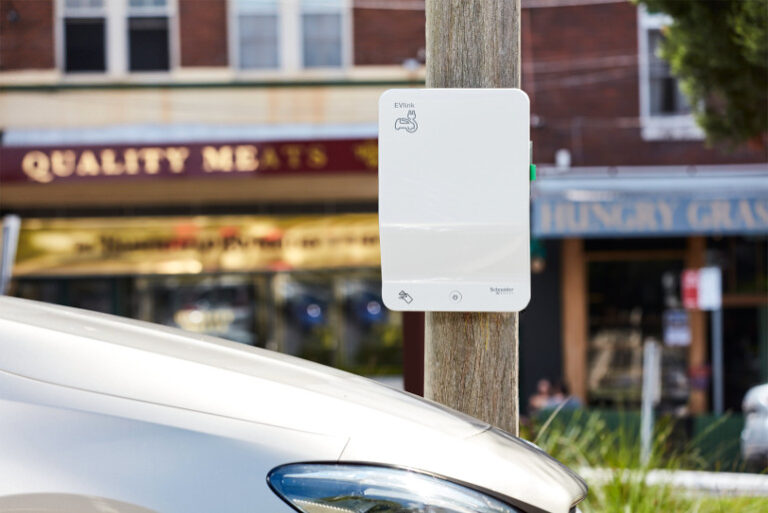Charging infrastructure is one of the big concerns for Fleet Managers and novated lease buyers when considering the purchase of an electric vehicle. Many experts are saying that the majority of charging will happen at home but for inner city residents that park on the street, this isn’t an option.
Many residents can see the obvious solution when they look up and are asking, “Why can’t we access the electricity that is connected to the pole in our street?”
Unfortunately when you’re working with the electricity the solutions are simple. The system is designed and built to handle a planned level of usage, and any significant increases (or spikes) can have disastrous results.
To understand the impacts and opportunities of kerbside EV charging, a trial is being launched in Sydney and the Hunter Region where street side power poles will be turned into public charging stations. It is estimated that one on-street charger can service 10 households.
There will be 50 locations selected as part of the project and each electric vehicle charge point will be connected to the existing electricity supply in the street with the energy use matched with 100% GreenPower from Origin Energy.
The objectives of the project are to demonstrate how existing street furniture (this is how the pole are classified) can be used for EV charging and to test the commercial viability of kerbside EV charging. The project term will about the impact of allowing electric vehicles to access the existing electricity network.
Local Government Partners
Here’s the list of councils that will be participating on the kerbside EV charging trial.
- Inner West Council
- Singleton Shire Council
- Waverley Council
- Lake Macquarie City Council
- Woollahara Council
- City of Ryde
- Randwick City Council
- Northern Beaches Council
- Parramatta City Council
The Australian Renewable Energy Agency (ARENA) is providing $871,000 in funding for the project. ARENA CEO Darren Miller said power pole charging provided the perfect solution to increasing public EV chargers.
“Not all electric vehicle owners have the ability to charge their vehicle at home, which is why we’re excited to partner with Intellihub on this trial that utilises street side power poles, providing a great opportunity to pair with EV charging.
“We look forward to seeing the results of the trial from Intellihub and hope to see it rolled out right across Australia.” Mr Miller said.
Smart metering and data intelligence provider Intellihub will lead the project, which is being delivered by several energy and EV businesses in partnership with local councils.
The charging station sites will be nominated by up to nine local councils taking part in the project. Nominations will be based on feedback from residents, expected demand, traffic access, and parking availability.
Intellihub CEO Wes Ballantine said the project would help tackle the lack of public access to EV chargers, particularly for the one in four Australian households which do not have off street parking.
“It’s expected that as many as 10 percent of new car sales in Australia will be electric vehicles by 2025,” Mr Ballantine said.
“That equates to an extra 120,000 new EVs on our local streets each year. It is likely that many of these car owners may be unable to charge their EVs from home.
“Power poles line most of our public streets and that presents an opportunity for the EV charging market. They’re an accessible, safe, and practical option for EV charging.
“They’ll be installed in front of the meter making them a controllable resource for grid operators looking to better manage the increasing penetration of renewables connected to the electricity network.”
Potential locations for charging stations include areas near apartment buildings and high-density single dwelling suburban streets, shopping strips, bus or train stations, sporting facilities and hospitals.
EV charging specialist at Withywindle David Anstee said there was potential for 190,000 public street- side EV charging stations across the country.
“Thousands of power or light pole-based EV chargers have already been successfully deployed across London, Germany, Canada, and the United States,” Mr Anstee said.
“This trial will help us understand and overcome any regulatory barriers and build a commercial model that is fit for purpose for Australian conditions. It will uncover the charging habits of Australian EV owners across different locations and with different incentives.
“And it will give energy suppliers insights into how to use electric vehicles to soak up excess rooftop solar power during high generation periods.”
The trial is also expected to provide safer ways for EV owners without off street parking to charge their cars. Local councils are receiving regular reports of cars being charged via extension cords strung from homes to cars parked on the street.
Schneider Electric Vice President Power Products & Digital Power Farokh Ghadially said the EV charging technology offered easy to use charging facilities for type 1 and 2 electric vehicles.
“Schneider Electric’s EV charging units provide greater control of energy distribution through AutoGrid Flex, a leading virtual power plant system,” Mr Ghadially said.
“This technology combines a number of independent power sources, like local solar power and the grid, to provide a reliable supply of electricity. This helps meet additional EV power needs, without compromising the local grid, all while reducing charging costs.”
The customer engagement platform for the project will be provided by EV specialists EVSE and the virtual power plant and distributed energy solutions will be managed by AutoGrid.






